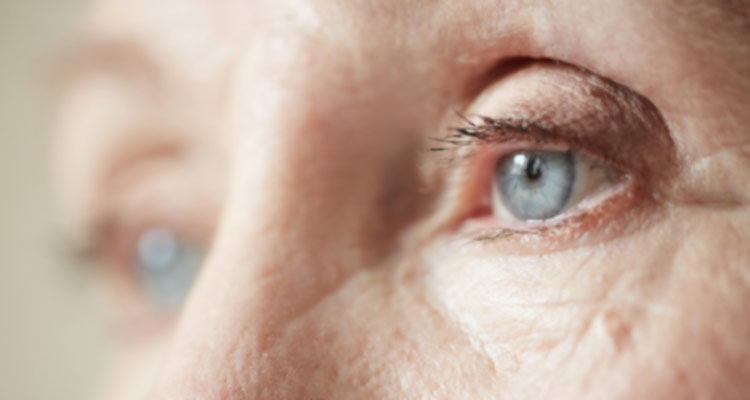Alzheimer’s disease can be a root cause for a wide range of symptoms ― memory loss, confusion, and changes in mood or personality, to name a few. Many caregivers are unaware that Alzheimer’s disease can actually affect their loved one’s vision. In fact, recent studies suggest that one of the earliest detectable symptoms of Alzheimer’s could be certain problems affecting eyesight.
For caregivers of those with Alzheimer’s or dementia, knowing how Alzheimer’s could affect your loved ones’ vision could help prevent injury and help you better provide care and support for them. Here’s what you should know.
Common Vision Problems Associated with Alzheimer’s
The American Academy of Ophthalmology explains that Alzheimer’s disease can affect vision in various ways because it influences how the brain interprets images being received by the eyes. These changes can manifest themselves in various ways as the disease progresses.
According to Richard A. Armstrong in “Alzheimer’s Disease and the Eye,” various visual changes have been reported in those with Alzheimer’s, including:
- Visual acuity changes (clarity or sharpness of vision)
- Color vision
- Object recognition
- Reading ability
While many of the reported symptoms are also common in older adults in general, optometrists have noticed patterns in symptoms often shared by people with Alzheimer’s. Here are some more common ones:
Impaired Depth Perception
According to one study, patients with mild Alzheimer’s disease had impaired depth perception due to neurological effects on the visual cortex ― the part of the brain that handles visual perception.
This means that people with Alzheimer’s can have trouble judging how far away an object is from them, and they can also have difficulty distinguishing between flat objects and three-dimensional objects. This can make simple tasks, such as picking up an item in front of them, harder to do.
Diminished Peripheral Vision
Alzheimer’s effects on the occipital lobe of the brain can hinder one’s peripheral vision ― what they can see outside their direct line of vision ― making it harder for them to see what’s going on around them. It can also make moving around riskier, as they are more vulnerable to stepping or tripping on objects they can’t see off to the side.
Difficulty Seeing Different Colors
Many people with Alzheimer’s disease or dementia have trouble seeing certain colors or telling the difference between similar colors. For example, they may not be able to make out the difference in color between a dark-colored cup and the grape juice inside. The same goes for their surroundings ― such as being unable to see where a floor ends and a wall begins, if both are similar in color.
Trouble Recognizing Familiar Objects
Because Alzheimer’s can affect the way the brain interprets information from the eyes, a person with the disease may be able to see an object correctly without recognizing it. Armstrong’s study indicates that patients with Alzheimer’s “show impairment of eye-head coordination, problems with finding objects when surrounded by others, and in finding known objects in an unknown environment.”
This explains why it can be harder for them to name or identify familiar things or people they are looking at.
Reduced Ability to Detect Motion
According to Seniorlink, those with Alzheimer’s may face trouble detecting motion. To someone struggling with this type of vision problem, “instead of being able to see things as an ongoing video, they identify the world as a series of still photos.” This can make activities that involve motion ― like watching a sporting event or television ― more challenging.
What You Can Do to Assist Your Loved One
Knowing the signs of vision loss, there are actions and precautions you can take to help prevent your loved one from being injured, keep their eyes healthier for longer, and improve their quality of life.
This caregiver guide from visionaware.org recommends several tips for making your loved one’s environment safer and more comfortable for them in the face of vision problems.
Use Contrasting Colors
Take a look at your loved one’s surroundings at their current residence. Are there a lot of similar colors throughout? Making simple cosmetic changes, such as painting a wall a different color or replacing light-colored furniture with dark-colored furniture could help your loved one get around better. During mealtimes, try using brightly colored plates and cups to provide visual cues for your loved one. Ensure there is plenty of lighting throughout the home.
Be Proactive
If you see something that could lead to a potential mishap, resolve it as soon as you notice it. For example, if you go to a restaurant with your loved one and see an object in their path, move it out of the way before they get to it.
Or if you notice your loved one’s home or apartment has little space to walk from the kitchen to the living room, move a piece of furniture or two somewhere else to make a clearer path for them.
Encourage Regular Eye Exams
Help your loved one stay on top of their eye health by arranging and/or taking them to regular eye exams. Keeping their eye doctor in the loop can help with diagnosing any vision problems and recommending appropriate treatment.
More Caregiving Resources for You to Explore
If you found this article helpful, check out The Bristal Blog for more information, including tips, guides, and tools that can help with everything from caregiving and family to healthy lifestyle to searching for senior living options.



